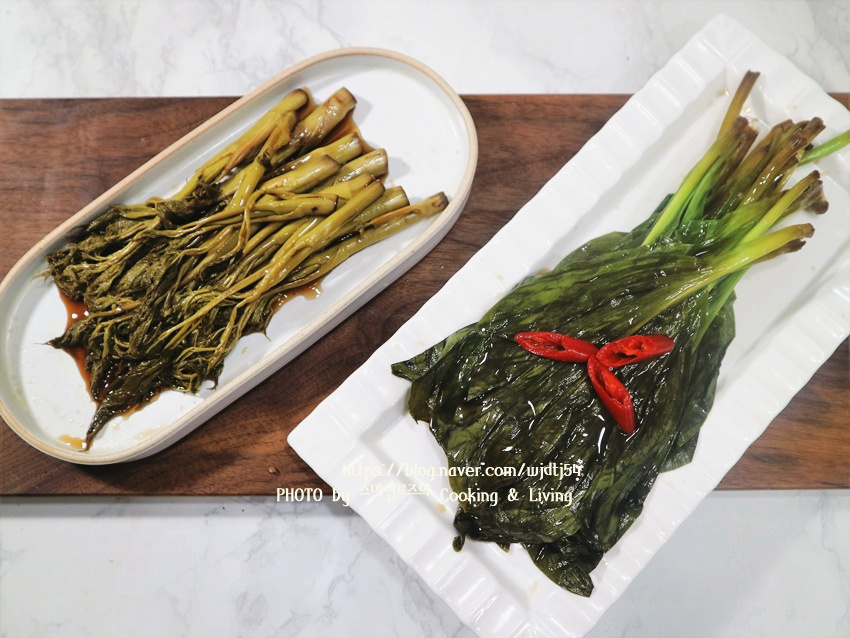Pickled Wild Garlic (Myeonginamul) and Deuruchjang (Mountain Celery) Jangajji: A Seasonal Delicacy for Year-Round Enjoyment
A Detailed Recipe for Preserving the Fresh Flavors of Seasonal Myeonginamul and Deuruchjang Jangajji

Discover the art of preserving the vibrant flavors of Myeonginamul (Korean wild garlic) and Deuruchjang (a type of mountain herb, also known as Sam-namul) with this comprehensive jangajji (pickled condiment) recipe. Myeonginamul, at its seasonal peak now, offers a delightful garlicky aroma, while Deuruchjang is renowned for its complex taste profile reminiscent of ddukb (edible shoots), ginseng, and meat, earning it the nickname ‘Sam-namul’ or ‘three-flavored herb’. Using these precious ingredients, generously provided by Abum Farm, you can create a delicious jangajji that will enhance your meals for an entire year. This pickled delight is perfect for boosting your appetite, especially when served with rice. #MyeonginamulJangajji #DeuruchjangJangajji #WildGarlicPickles #MountainHerbs #SideDish #SeasonalCooking #Homemade
Main Ingredients- Myeonginamul (Korean Wild Garlic) 2kg
- Deuruchjang (Sam-namul / Mountain Celery) 1.5kg
Broth Ingredients- Dried Shiitake Mushrooms 25g
- Dried Radish 30g
- Jujubes (Dates) 30g
- Kelp 15g
- Dried Velvet Mushrooms 20g
- Apple 1 whole
- Licorice Root a small amount
- Water 6L
Jangajji Sauce Ratio- Broth 1 part : Soy Sauce 1 part : Soju 0.5 part : Vinegar 0.5 part : Sugar 0.5 part
- Dried Shiitake Mushrooms 25g
- Dried Radish 30g
- Jujubes (Dates) 30g
- Kelp 15g
- Dried Velvet Mushrooms 20g
- Apple 1 whole
- Licorice Root a small amount
- Water 6L
Jangajji Sauce Ratio- Broth 1 part : Soy Sauce 1 part : Soju 0.5 part : Vinegar 0.5 part : Sugar 0.5 part
Cooking Instructions
Step 1
Place the Myeonginamul in a sink, fill with water to cover, and generously sprinkle with baking soda. Let it soak for about 20 minutes. Afterward, rinse each leaf thoroughly under running water and drain completely. For best results, wash them in the evening and let them drain overnight, propping them upside down to ensure maximum water removal before pickling the next morning.

Step 2
Prepare the Deuruchjang by soaking it in a baking soda and water mixture. Rinse it thoroughly under running water and drain well.

Step 3
Feel free to use any broth ingredients you have on hand. This recipe allows for flexibility, so don’t hesitate to add other vegetables or ingredients to enhance the broth’s flavor.

Step 4
Simmer a generous amount of broth using various ingredients available at home. This homemade broth will serve as the flavorful base for your Myeonginamul, Deuruchjang, or even other types of jangajji.

Step 5
For Myeonginamul jangajji, prepare the sauce with the following ratio based on the brewed broth: 4 cups broth, 4 cups soy sauce, 2 cups sugar, 2 cups soju, and 2 cups vinegar. For Deuruchjang jangajji: 1 cup broth, 2 cups soy sauce, 0.5 cup sugar, 0.5 cup soju, and 0.5 cup vinegar. Initially, boil only the broth, soy sauce, and sugar. The soju and vinegar will be added after the boiling mixture has cooled slightly.

Step 6
Combine the soy sauce and broth in a pot and bring it to a rolling boil. Once boiling, turn off the heat. Stir in the soju and vinegar. Allow it to sit for a moment to let the alcohol evaporate slightly before use.

Step 7
After draining, pat the Myeonginamul dry with paper towels to remove any residual moisture. Layer the leaves neatly in a clean storage container, arranging them in a zig-zag pattern for even distribution.

Step 8
Pour the prepared soy sauce mixture evenly over the Myeonginamul. Ensure the leaves are fully submerged in the liquid for proper pickling.

Step 9
To keep the Myeonginamul submerged, place a heavy ceramic plate or a pickling weight on top. The next day, flip the leaves to ensure the sauce permeates evenly. After about 5 days, strain all the liquid out of the container, bring it to a boil, let it cool completely, and then pour it back over the Myeonginamul. This step is crucial for long-term preservation, even at room temperature. (If refrigerator space is limited, repeating this boiling and cooling process 2-3 times will allow for safe room temperature storage.)

Step 10
Trim off about 2cm from the tough, fibrous ends of the Deuruchjang. Wash the trimmed pieces thoroughly.

Step 11
Bring a large pot of water to a rolling boil and add a pinch of coarse salt. Blanch the Deuruchjang, starting with the stem ends, until tender-crisp. Immediately rinse them under cold running water to stop the cooking process and drain them thoroughly. Blanching before pickling helps maintain a crisp texture.

Step 12
Arrange the drained Deuruchjang in a storage container in a zig-zag pattern. Pour the prepared soy sauce mixture over them, ensuring they are well covered.

Step 13
Similar to the Myeonginamul, place a heavy ceramic plate or pickling weight on top of the Deuruchjang to keep it submerged in the brine.

Step 14
After about 5 days, carefully strain the soy sauce mixture from the Deuruchjang. Reheat the brine to a boil, let it cool completely, then pour it back over the jangajji. Cover the container with plastic wrap to seal it. For room temperature storage, repeat this boiling and cooling process approximately 3 more times to ensure it lasts.

Step 15
This is the Myeonginamul jangajji after 3 days of pickling. While the flavors are still developing, it’s already delicious and not overly salty, offering a refreshing taste that stimulates the appetite. The flavor will deepen further with time.

Step 16
Here is the Deuruchjang jangajji after 3 days. It boasts a delightful crisp texture and a clean, non-salty taste. It’s a wonderful alternative to ddukb pickles. These two jangajji are staple side dishes in our home, enjoyed throughout the year.

Step 17
Having prepared these two types of homemade jangajji brings a sense of comfort and readiness for delicious meals. Create a bountiful and healthy dining experience with your carefully crafted pickles.



